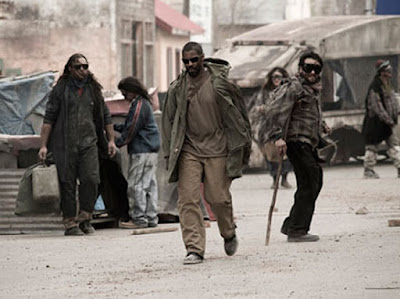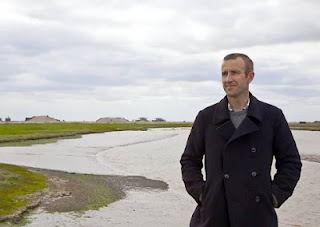Because a little John Ruskin goes a long way, I included only a short quotation from him about Turner in my last blog post. Now I realize I might have quoted a little more, for reasons that I think will become obvious.
The longer quotation runs as follows: “he (Turner) has admitted into his work the modern feeling of the picturesque, which, so far as it consists in a delight in ruin, is perhaps the most suspicious and questionable of all the characters distinctively belonging to our temper, and art.
“It is especially so, because it never appears, even in the slightest measure, until the days of the decline of art in the seventeenth century. The love of neatness and precision, as opposed to all disorder, maintains itself down to Raphael's childhood without the slightest interference of any other feeling; and it is not until Claude's time, and owing in great part to his influence, that the new feeling distinctly establishes itself.”
Well, are we sure about this? The Claude in question is, of course, Claude Lorrain, originally Claude Gellée, a French Baroque painter, c 1600 to 1682, one of those artists that it’s very difficult for a modern sensibility to embrace. His well-ordered, idealized, “noble” landscapes, often bathed in a golden glow with a few “picturesquely” placed peasants seem, regardless of what Ruskin says, rather too neat and precise. To a modern eye, at least mine, the presence of ruins actually comes as a welcome element of appealing disorder.
But I assume Claude himself would have felt that way at all. He lived most of his productive life in Rome and was, according to the biographies, a great walker around Rome and its hills. Then, as now, the people of Rome walked, and went about their daily lives, surrounded by ruins.
Julian Bell in the London Review of Books, reviewing an exhibition of Claude’s work at the Ashmolean in 2011 writes, “Claude would walk out of town and along the Tiber. The drawings in the show include discoveries made by pen and brush while looking at riverbanks, farmsteads, ruins and trees. They have a happy urgency, driven by a longing to memorise fleeting tonal relations so that, back in the studio, an invented arrangement of planes could be modulated until it looked like a scene observed.” By which I think he means that Claude walked out, looked around him, liked what he saw, but thought he could improve on it. He’d have loved Photoshop. OK, hold that thought.

Recently I’ve been enjoying a website titled BLDGBLOG run by Geoff Manaugh, a writer and editor who sometimes seems to be described as a “futurist.” The website professes to be concerned with “Architectural Conjecture: Urban Speculation: Landscape Futures,” but it’s a lot more fun than that might sound. There’s a book too, titled The Bldg Blog Book, which I have bought for cash money. The website is here:
Manaugh isn’t engaged with walking per se, but when people talk about the future and reconfiguration of cities it’s a topic that tends to come up. There’s a laceratingly hilarious piece on the blog when he goes to an event discussing “great streets” and becomes increasingly enraged “because the moderator turned the whole thing into a kind of ‘what's your favorite street in LA?’ quiz.” And having ventilated mightily on his own website he admits, “Not that I chimed in; lamely, I left the minute it ended and walked home to eat some dinner.” A man after my own heart.

Anyway, on the blog and in the book there’s an interview with Simon Norfolk, who is a war photographer, though hardly in the tradition of Robert Capa or Don McCullin. He’s concerned, at least in part, with the aftermath of war, in ruined landscapes, blasted infrastructures, and more or less destroyed buildings, and he does manage to find some gorgeous, if obviously problematic, beauty in these subjects. He says he’s concerned with “the military sublime.”
Part of the interview runs as follows:
BLDGBLOG: Your photos are usually unpopulated. Is that a conscious artistic choice, or do you just happen to be photographing these places when there's no one around?
Norfolk: Well, part of this interest of mine in the sublime means that a lot of the artistic ideas that I'm drawing on partly come out of the photography of ruins. When I was in Afghanistan photographing these places – photographing these ruins – I started looking at some of the very earliest photojournalists, and they were ruin photographers: Matthew Brady's pictures of battlefields at Gettysburg, or Roger Fenton's pictures from the Crimea. And there are no dead bodies. Well, there are dead bodies, but that’s very controversial – the corpses were arranged, etc. "But a lot of those photographers were, in turn, drawing upon ideas from 17th century and 18th century French landscape painting – European landscape painting. Claude Lorraine. Nicolas Poussin. Ruins have a very particular meaning in those pictures. They're about the folly of human existence; they're about the foolishness of empire. Those ruins of Claude Lorraine: it's a collapsed Roman temple, and what he's saying is that the greatest empires that were ever built – the empire of Rome, the Catholic church – these things have fallen down to earth. They all fall into ivy eventually. "So all the empires they could see being built in their own lifetimes – the British empire, the French empire, the Dutch empire – they were saying: look, all of this is crap. None of this is really permanent: all of these things rise and fall. All empires rise and fall and, in the long run, all of this is bullshit."
Well, I don’t know if Claude would have put it quite like that. And John Constable certainly wouldn’t, and didn’t. He said that in Claude’s landscapes "all is lovely – all amiable – all is amenity and repose; the calm sunshine of the heart." Because I tend to share Norfolk’s sensibility, I agree it would be really nice to think that even as Claude was selling idealized landscapes to rich clients, and making himself rich in the process, he was an anti-Imperialist avant la lettre, but I’m not sure he really was.
Manaugh asks Norfolk why there are so few people in his photographs and he replies, “I think people kind of gobble up the photograph. They become what the photograph is.” I understand his point but I think he protests a little too much: some of his pictures do indeed include people, and they’re often the ones I like best. And the fact is I like Simon Norfolk's work very much indeed.
Claude apparently had no such agonies about including people in his images. His landscapes are usually populated to a greater or lesser degree. Sometimes the people are just another compositional element but by no means always, as in The Walk to Emmaus. That’s Jesus walking in the middle.
Simon Norfolk, in a different interview that can be found on his website, does however, say something about walking that I absolutely treasure, "Walking a Kabul street can be like walking through a Museum
of the Archaeology of War - different moments of destruction lie like sediment on top of each other." I wonder if Claude would have even known what he was talking about. I hope so.
Simon Norfolk’s website is here:







































